Connect With Us
Blog
Items filtered by date: April 2025
Early Signs of Bunions
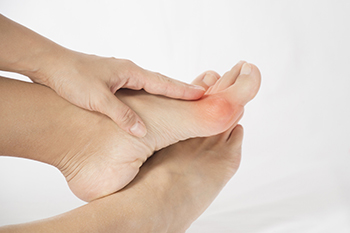
Bunions are a common foot deformity where the joint at the base of your big toe becomes enlarged and shifts outward. This misalignment can lead to a visible bump on the side of the foot and discomfort during daily activities. Early signs of bunions include redness, swelling, thickened skin, and tenderness around the big toe joint. As the condition progresses, pain may worsen, and wearing shoes can become increasingly uncomfortable. Bunions can be caused by genetics, wearing improper footwear like tight or high-heeled shoes, flat feet, or arthritis. The pain can feel like a persistent ache or sharp discomfort when walking or standing for long periods. A podiatrist can evaluate the severity of the bunion and provide relief through conservative treatments like padding, orthotics, footwear changes, and anti-inflammatory therapies. In more severe cases, surgery may be recommended to correct the deformity. If you have a painful bunion, it is suggested that you schedule an appointment with a podiatrist for appropirate treatment.
If you are suffering from bunions, contact one of our podiatrists of Save Your Soles. our doctors can provide the care you need to keep you pain-free and on your feet.
What Is a Bunion?
A bunion is formed of swollen tissue or an enlargement of boney growth, usually located at the base joint of the toe that connects to the foot. The swelling occurs due to the bones in the big toe shifting inward, which impacts the other toes of the foot. This causes the area around the base of the big toe to become inflamed and painful.
Why Do Bunions Form?
Genetics – Susceptibility to bunions are often hereditary
Stress on the feet – Poorly fitted and uncomfortable footwear that places stress on feet, such as heels, can worsen existing bunions
How Are Bunions Diagnosed?
Doctors often perform two tests – blood tests and x-rays – when trying to diagnose bunions, especially in the early stages of development. Blood tests help determine if the foot pain is being caused by something else, such as arthritis, while x-rays provide a clear picture of your bone structure to your doctor.
How Are Bunions Treated?
- Refrain from wearing heels or similar shoes that cause discomfort
- Select wider shoes that can provide more comfort and reduce pain
- Anti-inflammatory and pain management drugs
- Orthotics or foot inserts
- Surgery
If you have any questions, please feel free to contact our offices located in Abington and Willow Grove, PA . We offer the newest diagnostic and treatment technologies for all your foot care needs.
Common Foot Conditions in Children
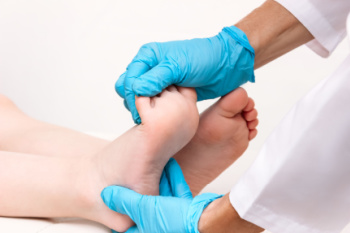
Many children have differences in how their feet look or move as they grow. Some common lower extremity abnormalities include flat feet, in-toeing, or feet turning inward, and out-toeing, or feet turning outward. Most of these conditions are normal in young children and often improve with time as the bones and muscles develop. A podiatrist will check how your child stands, walks, and moves to see if the condition is part of typical growth or if it needs treatment. In some cases, special shoes, exercises, or braces may help. Rarely, further testing or treatment is needed if the problem causes pain or limits activity. Regular check-ups can help make sure your child’s feet are developing properly. If you notice unusual walking patterns or your child is in pain, it is suggested that you see a podiatrist for an evaluation.
The health of a child’s feet is vital to their overall well-being. If you have any questions regarding foot health, contact one of our podiatrists of Save Your Soles. our doctors can provide the care you need to keep you pain-free and on your feet.
Tips for Keeping Children's Feet Healthy
- Make sure their shoes fit properly
- Look for any signs of in-toeing or out-toeing
- Check to see if they have Clubfoot (condition that affects your child’s foot and ankle, twisting the heel and toes inward) which is one of the most common nonmajor birth defects.
- Lightly cover your baby’s feet (Tight covers may keep your baby from moving their feet freely, and could prevent normal development)
- Allow your toddler to go shoeless (Shoes can be restricting for a young child’s foot)
- Cut toenails straight across to avoid ingrown toenails
- Keep your child’s foot clean and dry
- Cover cuts and scrapes. Wash any scratches with soap and water and cover them with a bandage until they’ve healed.
If you have any questions, please feel free to contact our offices located in Abington and Willow Grove, PA . We offer the newest diagnostic and treatment technologies for all your foot care needs.
Watching Your Child’s Walk Take Shape
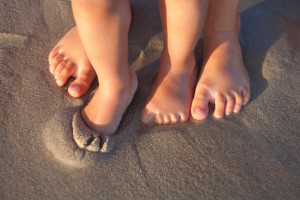
As children grow, their gait, or the way they walk, develops in stages that reflect both physical and neurological maturity. It is normal for toddlers to walk with their feet wide apart or appear a bit unsteady at first. Over time, their coordination improves, and their stride becomes more fluid. However, certain patterns like frequent tripping, toe-walking, or limping may signal developmental concerns that should not be overlooked. Early identification of gait abnormalities can help prevent future discomfort or mobility challenges. A child’s foot structure, muscle tone, and even leg alignment all play a role in how they move. Paying attention to how your child walks, runs, and stands can provide early clues to potential issues that may benefit from professional guidance. If you notice irregularities in your child’s gait or foot development, it is suggested that you see a podiatrist for an exam and necessary treatment.
If you have any concerns about your feet, contact one of our podiatrists from Save Your Soles. our doctors can provide the care you need to keep you pain-free and on your feet.
Biomechanics in Podiatry
Podiatric biomechanics is a particular sector of specialty podiatry with licensed practitioners who are trained to diagnose and treat conditions affecting the foot, ankle and lower leg. Biomechanics deals with the forces that act against the body, causing an interference with the biological structures. It focuses on the movement of the ankle, the foot and the forces that interact with them.
A History of Biomechanics
- Biomechanics dates back to the BC era in Egypt where evidence of professional foot care has been recorded.
- In 1974, biomechanics gained a higher profile from the studies of Merton Root, who claimed that by changing or controlling the forces between the ankle and the foot, corrections or conditions could be implemented to gain strength and coordination in the area.
Modern technological improvements are based on past theories and therapeutic processes that provide a better understanding of podiatric concepts for biomechanics. Computers can provide accurate information about the forces and patterns of the feet and lower legs.
Understanding biomechanics of the feet can help improve and eliminate pain, stopping further stress to the foot.
If you have any questions please feel free to contact our offices located in Abington and Willow Grove, PA . We offer the newest diagnostic and treatment technologies for all your foot and ankle needs.
Are You Suffering From Nerve Damage?
Recognizing the Symptoms of a Broken Ankle
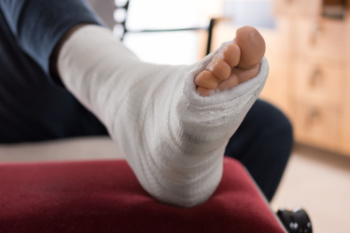
A broken ankle can cause significant discomfort and mobility issues. One of the most noticeable symptoms is intense pain, which often worsens with movement or pressure. Swelling and bruising surrounding the ankle are common due to internal bleeding and inflammation. In severe cases, joint deformity may be present, indicating a misalignment of the bones. Many individuals with a broken ankle find it impossible to bear weight on the affected foot, as any attempt to stand or walk can cause extreme pain. The area may also feel tender to the touch, and the skin might appear discolored. If you have fallen and have any of the above symptoms, it is suggested that you promptly contact a podiatrist who can provide an accurate diagnosis and offer appropriate treatment solutions.
Broken ankles need immediate treatment. If you are seeking treatment, contact one of our podiatrists from Save Your Soles. our doctors can provide the care you need to keep you pain-free and on your feet.
Broken Ankles
A broken ankle is experienced when a person fractures their tibia or fibula in the lower leg and ankle area. Both of these bones are attached at the bottom of the leg and combine to form what we know to be our ankle.
When a physician is referring to a break of the ankle, he or she is usually referring to a break in the area where the tibia and fibula are joined to create our ankle joint. Ankles are more prone to fractures because the ankle is an area that suffers a lot of pressure and stress. There are some obvious signs when a person experiences a fractured ankle, and the following symptoms may be present.
Symptoms of a Fractured Ankle
- Excessive pain when the area is touched or when any pressure is placed on the ankle
- Swelling around the area
- Bruising of the area
- Area appears to be deformed
If you suspect an ankle fracture, it is recommended to seek treatment as soon as possible. The sooner you have your podiatrist diagnose the fracture, the quicker you’ll be on the way towards recovery.
If you have any questions, please feel free to contact our offices located in Abington and Willow Grove, PA . We offer the newest diagnostic and treatment technologies for all your foot care needs.
Relief From Painful Cracked Heels
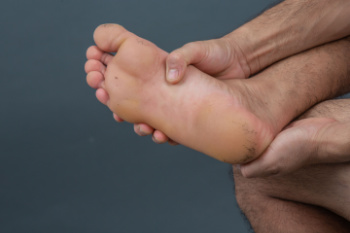
Cracked heels can be more than just a cosmetic issue, they can become painful, especially when the skin splits deep enough to bleed or become infected. Dry skin, standing for long periods of time, walking barefoot, or wearing open-back shoes often contribute to this problem. In some cases, medical conditions like diabetes or eczema can make the skin even more vulnerable. Treatment focuses on restoring moisture and healing the damaged skin. Regularly applying thick, emollient-rich creams or heel balms helps soften rough areas. Ingredients like urea, salicylic acid, or lactic acid are especially effective in breaking down thickened skin. Gently exfoliating calluses with a pumice stone can also prevent further splitting. In more severe cases, a podiatrist may recommend specialized treatments, debridement, or prescribe stronger topical medications. If you have painful or persistent cracked heels, it is suggested that you schedule an appointment with a podiatrist for proper care and lasting relief.
Cracked heels are unsightly and can cause further damage to your shoes and feet. If you have any concerns, contact one of our podiatrists from Save Your Soles. our doctors can provide the care you need to keep you pain-free and on your feet.
Cracked Heels
Cracked heels appear unappealing and can make it harder for you walk around in sandals. Aside from looking unpleasant, cracked heels can also tear stockings, socks, and wear out your shoes. There are several methods to help restore a cracked heel and prevent further damage.
How Do You Get Them?
Dry skin is the number one culprit in creating cracked heels. Many athletes, walkers, joggers, and even swimmers suffer from cracked heels. Age and skin oil production play a role to getting cracked heels as well.
Promote Healing
Over the counter medicines can help, especially for those that need instant relief or who suffer from chronic dry feet.
Wear Socks – Wearing socks with medicated creams helps lock in moisture.
Moisturizers – Applying both day and night will help alleviate dryness which causes cracking.
Pumice Stones – These exfoliate and remove dead skin, which allows for smoother moisturizer application and better absorption into the skin.
Change in Diet
Eating healthy with a well-balanced diet will give the skin a fresh and radiant look. Your body responds to the kinds of food you ingest. Omega-3 fatty acids and zinc supplements can also revitalize skin tissue.
Most importantly, seek professional help if unsure how to proceed in treating cracked heels. A podiatrist will help you with any questions or information needed.
If you have any questions, please feel free to contact our offices located in Abington and Willow Grove, PA . We offer the newest diagnostic and treatment technologies for all your foot care needs.

